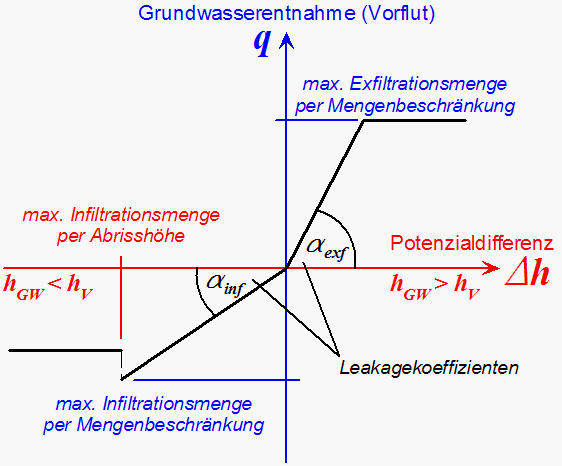Attributes:
MXKE for max. exfiltration[m³/TU/m] (polyline),
MXEE for max. exfiltration [m³/TU/m²] (elements, horizontal and 3D models only),
MXKI for max. infiltration [m³/TU/m] (polyline),
MXEI for max. infiltration [m³/TU/m²] (elements, horizontal and 3D models only)
Where TU = time unit specified in the model file
Maximum values for the infiltration/exfiltration rates for leakage relationships are specified using these attributes. For a polyline-wise limitation the units are m³/TU/m. The final maximum rate for the individual nodes is calculated by multiplying it by the half the distance between the node and the neighbouring nodes. For this reason, the correct order of the nodes is very important. The unit for the element-wise maximum rate is m³/TU/m². Here, the final value is obtained by multiplying it with the area of the corresponding element. Maximum infiltration rates can also be defined with the help of tear-off heights (data type ABRI, in conjunction with the stage of the watercourses VORF).
Examples:
MXKI = 0 means that no water infiltrates into the groundwater at these nodes (of a watercourse.
MXEI = 0 means that no water infiltrates into the groundwater in these elements.
MXKE = 0 means that no water from the groundwater arrives at these nodes (of a body of water).
MXEE = 0 means that no water from the groundwater arrives in these elements.
For coupled 2D/3D models, grouping of the MX** data must not continue across the boundary from the 2D to the 3D section. The grouping must be split at the boundary; otherwise, the limitations in the 3D section will have no effect.
(With inverse modelling, maximum infiltration/exfiltration rates are not available.)
The relationship between the individual parameters is illustrated in the following image:

Relationship between the leakage parameters
If leakage relationships with maximum infiltration and/or exfiltration rates are specified in a model, a calculation is automatically performed with each flow calculation iteration. If the calculated leakage rate exceeds the maximum infiltration or exfiltration rates at a leakage node or in a leakage element, the leakage boundary condition is switched off and the appropriate maximum rate is applied as a new boundary condition. Then, the iteration is continued until all the leakage rates are within the set limitations for all nodes and elements.
The leakage limitations can also be defined as a transient boundary condition via the attributes KMKE and KMKI.
